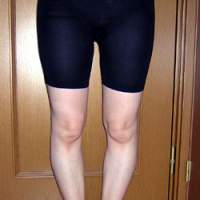Dear Alice,
While living in Tokyo a few years back, there was one thing that I never stopped wondering about: the incredible number of Japanese with crooked legs! It seems like more women are afflicted than men, but maybe that's just because they show more leg. I've yet to come across anyone who can explain this phenomenon, but I guess it's a combination of physical and nutritional factors. Do you have any idea what the heck is going on?
Philip P., Copenhagen, Denmark
Dear Philip,
By "crooked" I assume you mean legs that curve out below the knee, so that when someone is standing up straight with their feet together, their knees don't touch. In English, that's called "bowlegged;" in Japanese, it's O-kyaku -- O because the legs seem to form the letter O, and kyaku because that means leg. There's also X-kyaku, a knock-kneed stance where the knees are turned in toward each other while the lower legs splay out. O-kyaku is far more common; lots of people will tell you that 80 percent of Japanese people are bowlegged, but I couldn't find any real data to support that assertion.
Judging from my mailbox and Internet discussions, the shape of Japanese legs is a topic of endless fascination for foreigners, particularly men, who, for some reason, seem to spend a lot of time looking at Japanese women's legs. The prevailing theory among these keen observers is that Japanese legs get bent out of shape from sitting seiza -- on the floor in the traditional formal manner, with knees together and the lower legs tucked under the bottom and thighs.
I was skeptical about that because most of the Japanese people I know can't sit seiza any longer than I can (three minutes, tops), and they do it as little as possible. I just couldn't see it being an influence on leg shape anymore, yet you see still plenty of young people with bowlegs. I wondered how the average Japanese might explain O-kyaku, so I started asking around and reviewing popular-information sites on the Internet.
Japanese people generally blame bowlegs not on seiza but on other sitting positions. The most vilified is the childish-looking pechanko-zuwari (also called peshanko-zuwari and tonbi-zuwari), which is sitting on the floor with the legs splayed open on either side of the body, bent and turned so the inner knees and ankles are flat on the ground. Another position considered bad for the legs is yoko-zuwari (also called onnanoko-zuwari and onesan-zuwari), which is sitting on the floor with both legs bent at the knee on the same side of the body.
But none of those popular theories have a leg to stand on, according to Dr. Makoto Kamegaya, head of orthopedics at Chiba Children's Hospital. "Sitting with the legs tucked under or to the side doesn't cause bowlegs," he assured me, "and neither does pechanko-zuwari, although that position is linked to uchimata hoko (walking pigeon-toed with the feet turned in.)" Bowlegs can't be blamed on how you sit, he asserted, and except for very rare cases, nutrition isn't a factor either. So what gives?
"What looks to foreigners like a high incidence of bowleggedness among Japanese is really just a racial tendency to lower legs that curve outward, perhaps combined with a cultural preference for a slightly pigeon-toed stance," Kamegaya told me, explaining that it's easier to walk when wearing kimono if you turn the toes slightly inward. "That also produces what has long been considered a graceful, attractive gait. Few women wear kimono anymore, but the preference remains."
All humans are born bow-legged, but in most cases the legs straighten out naturally between ages 2 and 4. "Japanese are more likely to have curved tibia than Caucasians, and a certain degree of curvature is considered normal in both children and adults," according to Kamegaya. "But the incidence of true bowleggedness, which is called Blount's disease, is not significantly higher in Japan, and most doctors in this country follow the same general guidelines used overseas to decide when correction is necessary. That usually means surgery to cut the leg bone and reset it."
But what about all those products and services I saw on the Internet that purport to correct O-kyaku? "Maybe doing exercises and wearing special insoles will make people feel better about their legs, but, medically speaking, there's no way to change the shape of the bones in adults except surgery."
Sounds like you should cut the ladies a break, guys, and appreciate Japanese legs just the way they are.


















With your current subscription plan you can comment on stories. However, before writing your first comment, please create a display name in the Profile section of your subscriber account page.